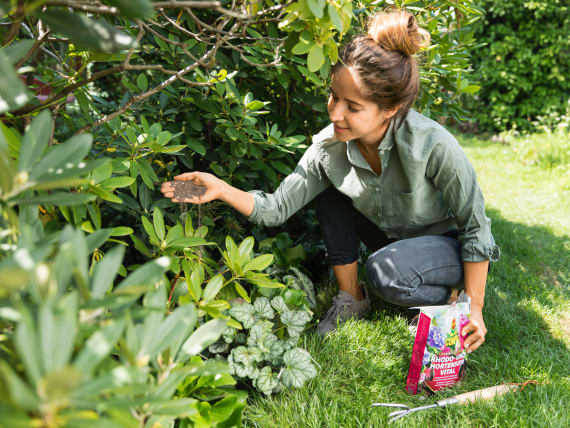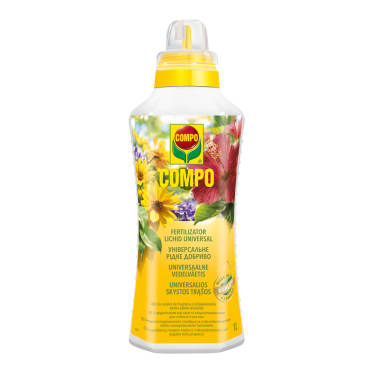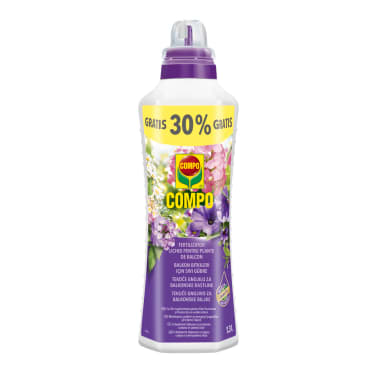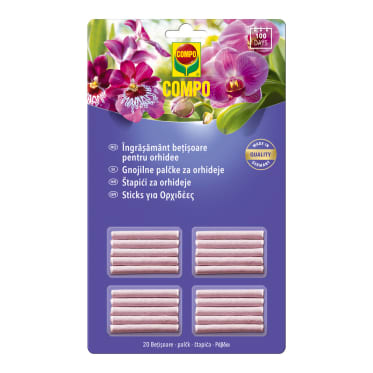Frequent search terms

- COMPO
- Guide
- Plant Care
- Basics
- Fertilisers and plant protection
- Fertilising properly: Energy for your plants
Fertilising properly: Energy for your plants
Nothing is possible without nutrients – that goes for both humans and plants alike. While we need vitamins, carbohydrates and the like to feel fit and healthy, plants also only really develop optimally if they are supplied with enough nutrients. Regular fertilisation is therefore key to good growth. The ingredients added to the fertiliser promote plant growth and strengthen plants' ability to ward off pests and diseases. Find out why, when and how much you should fertilise here.

Why are fertilisers good for plants?
Over time, plants draw important nutrients from the soil that they need to form leaves and flowers. These nutrients only return to the biogeochemical cycle when the plant sheds its leaves or dies in the autumn. When harvested crops or grass cuttings and dead plant parts are removed, nutrients are taken from the biogeochemical cycle and the soil becomes depleted. The consequences: pale leaves, protruding green veins and slow growth. Your plants will be spared from this if you regularly fertilise them – only then will they develop healthily and have resistance to diseases.
If you want to experience floral abundance and rich harvests, you should also ensure balanced fertilisation. The same applies as with our own nutrition: All nutrients need to be present in adequate quantities for optimal development. One nutrient cannot be replaced by another. If you keep a close eye on your plants, it is usually easy to spot whether they are lacking any nutrients and, if so, what type. For example, meagre growth and pale leaves are signs of a nitrogen deficiency. Whereas few flowers and small leaves are caused by too little phosphate. Weakness or limpness in plants is an indication of a calcium deficiency.
The most important nutrients and functions
What nutrients do plants need?
| Primary nutrient | Function |
|---|---|
Nitrogen | Responsible for the growth of plants. |
Phosphate | Supports flower and fruit formation and promotes the root growth of plants. |
Potassium | Increases plant resistance and improves the flavour of fruit and vegetables. |
Magnesium | Important for the formation of chlorophyll and affects the water supply of the plant. |
Calcium | Boosts the firmness of the tissue and increases the plant's resistance to stress. |
What are the differences between fertilisers?
A distinction is made between purely organic fertilisers made from natural materials, mineral fertilisers, which are industrially produced, and organic-mineral fertilisers.
Organic fertilisers
Organic fertilisers consist of plant-based and/or animal-based ingredients (e.g. grapeseed hulls, cocoa husks, horn shavings and seabird guano). The conversion of organic materials into nutrients that are available to plants is a slow, natural process (mineralisation). The natural raw materials first need to be broken down by microorganisms in the soil. This means that nutrients are slowly released over an extended period. Soil life is activated and humification promoted in the process.
Organic-mineral fertilisers
Nitrogen is the main by-product when organic materials are broken down in the soil by microorganisms. Organic fertilisers are enriched with mineral components so that plants can continue to be supplied with all important nutrients. The result is an organic-mineral fertiliser. Many organic-mineral fertilisers consist of 100% natural raw materials.
Mineral fertilisers
Mineral fertilisers contain nutrients that are important for plant nutrition in the form of minerals and salts. They dissolve into the soil moisture so that the plants can access the nutrients directly. As quick sources of energy with performance-enhancing effects, they are mainly used in plants with a high nutrient uptake and demanding continuous bloomers as well as to treat deficiency symptoms.
Besides instant mineral fertilisers, there are also slow-release mineral fertilisers, which continually release their nutrients in harmony with the natural growth factors of warmth and water over an extended period of time (generally three to six months). This ensures that plants have a sufficient supply of all required nutrients until the gardening season is over.
When is the best time to fertilise?
The most important rule for nutrient supply: Only fertilise during the growth period! Otherwise, perennials, fruit and vegetables will keep forming new shoots, leaving them susceptible to frost. It is therefore advisable to only fertilise until mid-August; after that only autumn fertilisers with added calcium should be used for shrubs and perennials. If it is very hot in the summer, you should water thoroughly before fertilising. The best time of the day is early in the morning or in the evening.
Liquid fertilisers
Liquid fertilisers penetrate the soil immediately and therefore take effect very quickly. Plants tolerate frequent fertilisation in small doses better. Slow-release fertilisers make things easier for gardeners because they take effect over a period of three to six months.

How much fertiliser does the plant need?
As every plant has different requirements, it is a good idea to use a fertiliser tailored to its needs. Too little fertiliser results in reduced growth and a less abundant harvest. Whereas an oversupply of nutrients also damages the plant, with the tissue becoming weak and the plant folding over more quickly in the wind. It also becomes prone to diseases and pests.
Among the different vegetable varieties there are plants with a weak, medium and high nutrient uptake, each requiring a different amount of nutrients. Those with a weak nutrient uptake include most herbs as well as peas and radishes: They do well with few nutrients. Plants with a medium nutrient uptake like strawberries, kohlrabi and carrots require a little more fertiliser. Plants with a high nutrient uptake that need the most amount of nutrients include tomatoes, cucumbers, pumpkin and cabbage. Similar distinctions are made between ornamental plants. We recommend researching the specific requirements of the crop before purchasing it and tailoring fertilisation to the plant. Precise dosage information can be found on all fertiliser packaging.
You might also be interested in these topics
Suitable COMPO fertilisers












